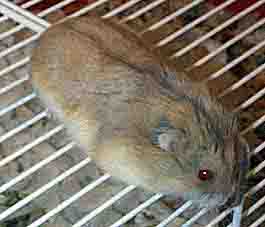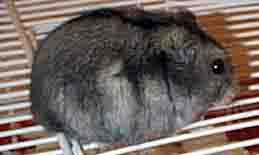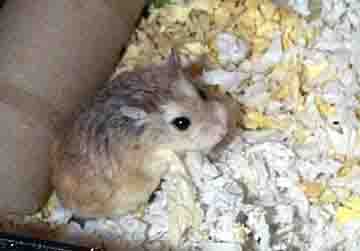
There are many different species of hamster. All of them come from the "Old World", (Europe and Asia), and each species usually bears the name of the country that it is found in.
Hamsters are Rodents, like rats, mice, gerbils, chinchillas, guinea pigs and chipmunks. This means that they have chisel like front teeth that grow throughout their lives. For this reason, hamsters, like all rodents, must gnaw on hard objects to keep their teeth from overgrowing. (The word, "rodent", means "one who gnaws").
Rodents are divided into several groups; the "Squirrel like" rodents, (Scuiriomorpha), the "Guinea Pig like" rodents, (Caviamorpha), the "Porcupine like" rodents, (Hystericomorpha) and the "Mouse like" rodents, (Myomorpha). Hamsters belong to the last group, the Myomorphs.
Myomorph rodents are usually small in size and frequently nocturnal in their habits. This group includes rats, mice, gerbils, voles and hamsters. Typically myomorphs have larger numbers of babies than the other types of rodents, and at more frequent intervals. This helps to replace their high losses; these rodents are the favourite food of many predators.
Myomorph rodents are broadly split into three sub groups; rats and mice, gerbils and their relatives, and hamsters, lemmings and voles. The different species of hamster form the family Cricetidae, all of which have large pouches in their cheeks for collecting food.
Hamster species vary in size from the European, or Common, Hamster, the size of a small guinea pig, to the Roborovskii's Dwarf Hamster, only 2" long. Their habitats range from the farmlands and meadows of Europe, through the cold plains and steppes of central Europe and Asia to the deserts of China and Mongolia. All, however, are still recognisably hamsters.
There are several species of hamster kept as pets but for practical purposes they can be split into Syrian hamsters and other species, (collectively referred to as "Dwarf" hamsters by many people). Syrian hamsters are solitary and must be kept alone, while other species can usually be kept in groups of their own kind. The different species and their different temperaments are described below.

Shorthaired Golden Female
This is animal that most people think of when they hear the word "hamster". The species originates in the Middle East, especially Israel and Syria. All Syrian hamsters in captivity are descended from a mother and her twelve pups who were dug out of a burrow near Aleppo, Syria, in 1930. Adults are fiercely territorial and will attack any other hamster they meet. Fully grown Syrian hamsters are about 6" in length, with females being slightly larger than males. The natural colour is golden brown with pale greyish white belly. Black cheek flashes mark the jaw line and a broad, dark band runs across the chest. In captivity over forty different colours have been developed, together with variations in coat type such as longhair, satinised and rex, (curly or wavy).
Well handled Syrian hamsters make excellent pets; they are bigger than the other species and can cope with more handling before they get tired. They also seem to respond more to what is going on around them. Females appear to have more "get up and go" in their characters than males, who tend to be more laid back. On average, however, males tend to outlive females.

Dominant Spot Chinese hamster.
These animals grow to 3" to 4" in length. Their body proportions, compared with those of other hamsters, appear "long and thin". In addition they have, for a hamster, a relatively long tail. The wild colour is greyish brown above with a black stripe down the spine and a whitish belly. This colouration, combined with their lithe build and longer tail, makes them look "mousy" to some eyes. However, they have quiet temperaments and are easily handled; one of their endearing traits is that of clinging to a finger with all four paws, rather like a harvest mouse on a corn stalk. Chinese hamsters can be quite nervous as youngsters but, once they are tame, display an endearing calmness and gentleness of character. They originate in the deserts of Southern China and Mongolia.

Normal & Mottled Female Campbell's Russian Hamsters
Also called the Striped Hamster, the Dzjungarian Hamster and the Hairy Footed Hamster, this is the commonest of the Dwarf hamsters and the most frequently available in pet shops. Size and colouring are similar to the Chinese hamster, but the build is totally different, being much broader and with a shorter, furry tail. In addition, the fur is very thick and woolly, unlike the silky fur of the Chinese hamster. This thick fur is an adaptation to their natural environment, the cold steppes of Central and Southern Russia.
Campbell's hamsters should be handled frequently, as their temperaments vary. Many are beautifully tame and quite enchanting, some may be a little nippy and a few can be absolutely foul, biting hard and deep at the slightest provocation. Before you purchase a hamster of this species as a pet I would strongly advise you to see it being handled by the breeder or pet shop owner. If the hamster is confident and friendly when they pick it up then you have probably chosen a most rewarding pet. If it bites them or, worse, they won't handle it at all, look somewhere else. Most Campbell's are delightful but a spiteful one is almost impossible to tame without investing a great deal of time, energy and hard work.

Argenté Female Campbell's Russian Hamster
Campbell's hamsters come in several colours; the Normal, (Grey), the Argenté, (Sandy to Ginger with red eyes), the Mottled, (Normal or Argenté with white patches), and the Albino. In addition there are a few Black Eyed Whites, Blacks and Platinums, (colour diluted to a pastel shade), around, mainly owned by breeders.

Normal Winter White Russian Hamster
These are very similar to the Campbell's Russian hamster; some people think they may in fact be the same species. They are, however, more "egg shaped" in conformation than the Campbell's variety, with less broad shoulders. In addition, Normal, (Grey), Winter Whites tend to be a clearer Grey than Normal Campbell's hamsters, with less of a brownish tinge. Winter White hamsters, also called Siberian hamsters, come from the steppes of Siberia and possess an adaptation not seen in Campbell's; they can moult into a white winter coat. This camouflages them against the snow and also gives them their name. As well as the Normal, (Grey), captive Winter White hamsters may be Sapphire, (Blue Grey) or Pearl, (permanently in the winter coat).

Normal & Sapphire Winter White Russian Hamsters
The temperaments of Winter White hamsters vary less widely than those of Campbell's hamsters. Generally they are like the nicer Campbell's; confident, outgoing and friendly. Winter White hamsters are mainly bred by exhibitors, so possibly more attention has been paid to their temperament, since Judges at Shows do not like being bitten!

Male Roborovskii's hamster
These are the newest addition to the family of hamsters kept as pets. They originate from Mongolia and are the smallest of the hamster family, being only about 2" long when fully grown. They are sandy brown on their head and back and pure white underneath, but have endearing white "eyebrows" and whiskers, as seen in the photograph above.
Roborovskii's hamsters are gentle and naturally docile but extremely fast! They rarely if ever bite but do wriggle - and if they escape they are difficult to catch. Repeated, gentle handling will calm them down over time, but they are not, in my opinion, a pet for those who want an animal that can be cuddled and played with. The other side of this very active nature, however, is that they make ideal pets for anyone who wants an animal that is active and interesting to watch.